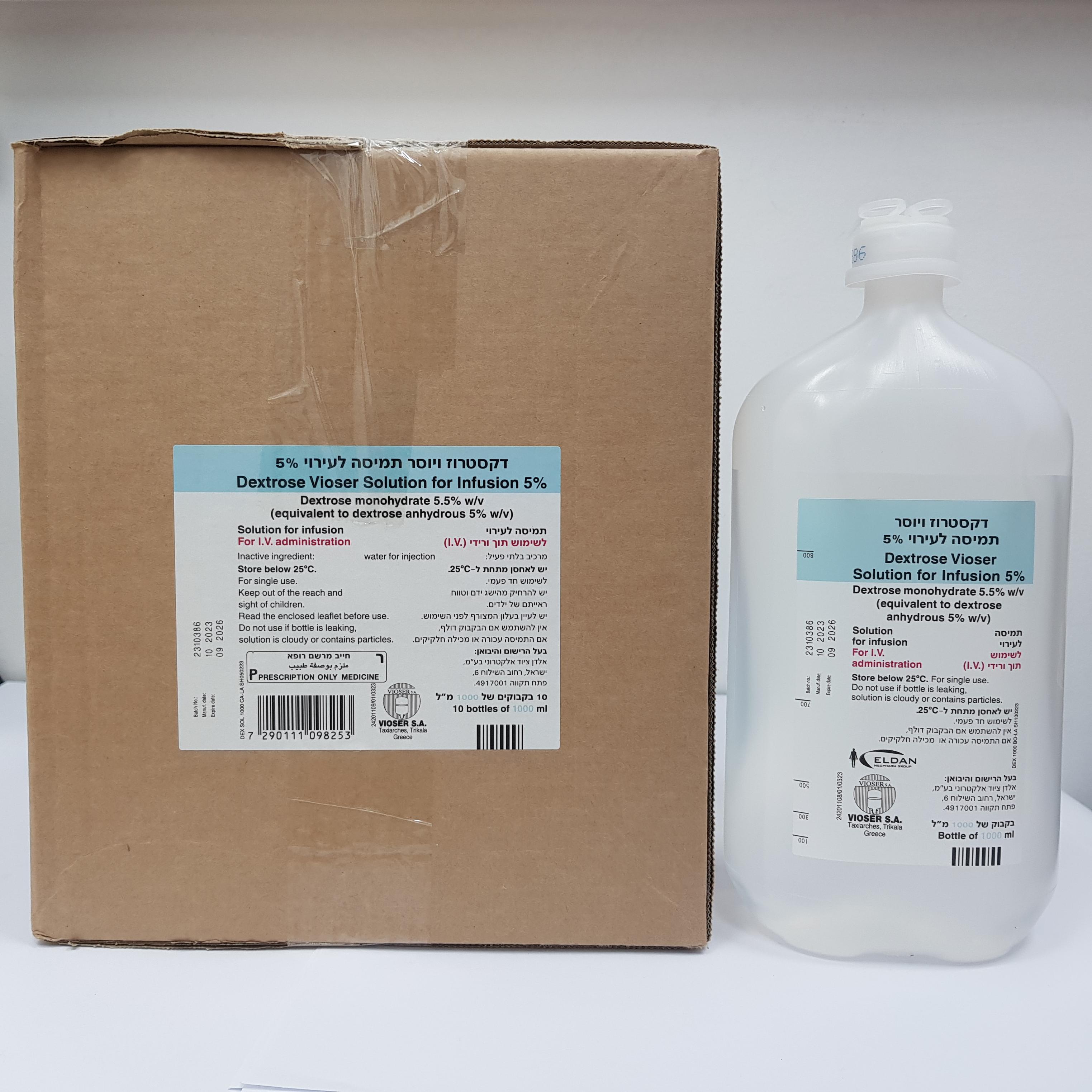Quest for the right Drug

דקסטרוז ויוסר תמיסה לעירוי 5% DEXTROSE VIOSER SOLUTION FOR INFUSION 5 % (DEXTROSE ANHYDROUS, DEXTROSE AS ANHYDROUS)
תרופה במרשם
תרופה בסל
נרקוטיקה
ציטוטוקסיקה
צורת מתן:
תוך-ורידי : I.V
צורת מינון:
תמיסה לאינפוזיה : SOLUTION FOR INFUSION
עלון לרופא
מינוניםPosology התוויות
Indications תופעות לוואי
Adverse reactions התוויות נגד
Contraindications אינטראקציות
Interactions מינון יתר
Overdose הריון/הנקה
Pregnancy & Lactation אוכלוסיות מיוחדות
Special populations תכונות פרמקולוגיות
Pharmacological properties מידע רוקחי
Pharmaceutical particulars אזהרת שימוש
Special Warning עלון לרופא
Physicians Leaflet
Special Warning : אזהרת שימוש
4.4 Special warnings and precautions for use Monitoring of blood glucose, fluid balance serum electrolytes, acid-base balance and serum potassium is necessary during administration of Dextrose Vioser Solution for Infusion 5%. In patients with disturbed glucose metabolism, as present e.g. in postoperative or posttraumatic conditions, Dextrose Vioser Solution for Infusion 5% must be administered with care, i.e. under blood glucose monitoring, and dosage must be adapted in order to prevent physiological stress. Dextrose Vioser Solution for Infusion 5% should only be administered with caution in patients with diabetes mellitus. Glucose infusions should not be administered through the same infusion equipment, simultaneously with, before, or after administration of blood, because of the possibility of pseudo-agglutination. Hyperglycemia and glycosuria may be functions of rate of administration or metabolic insufficiency. To minimize these conditions, slow the infusion rate, monitor blood and urine glucose; if necessary, administer insulin. When concentrated dextrose infusion is abruptly withdrawn, administer 5% dextrose to avoid hypoglycemic reactions. Administer so that extravasation does not occur. If thrombosis occurs during administration, stop infusion and correct. Clinical supervision should include regular checks of blood glucose level, serum electrolytes and water balance. Electrolytes are to be supplemented as required. Hypokalemia: Excessive administration of potassium free solutions may result in significant hypokalemia. Add potassium to dextrose solutions and administer to fasting patients with good renal function, especially those on digitalis therapy. Vitamin B complex deficiency may occur with dextrose administration. Caution is to be exercised in patients with hyponatremia. No other medication or substance should be added to this fluid, unless it is known to be compatible. Warnings This fluid should only be administered with great care to patients with renal insufficiency. Fluid/solute overload Dextrose solutions I.V. can cause fluid or solute overload resulting in dilution of serum electrolyte concentrations, overhydration, congested states of pulmonary edema. Hypertonic dextrose solutions may cause thrombosis if infused via peripheral veins, therefore, administer via a central venous catheter. Diabetes mellitus: Use dextrose-containing solutions with caution in patients with sub- clinical or overt diabetes mellitus or carbohydrate intolerance. Rapid administration of hypertonic solutions may produce significant hyperglycemia or hyperosmolar syndrome, especially in patients with chronic uremia or carbohydrate. In very low birth weight infants, excessive or rapid administration of dextrose injection may result in increased serum osmolality and possible intracerebral hemorrhage. Prolonged infusion of isotonic or hypotonic dextrose in water may increase the volume of extracellular fluid and cause water intoxication. To minimize the risk of possible incompatibilities arising from mixing this solution with other additives that may be prescribed, the final infusate should be inspected for cloudiness or precipitation immediately after mixing, prior to administration, and periodically during administration. Children In neonates or in very small infants even small volumes of fluid may affect fluid and electrolyte balance. Care must be exercised in treatment of neonates, especially pre-term neonates, whose renal function may be immature and whose ability to excrete fluid and solute loads may be limited. Fluid intake, urine output, and serum electrolytes should be monitored closely. Serum glucose concentrations should be frequently monitored when dextrose is prescribed to pediatric patients, particularly infants, neonates, and low birth weight infants. Use with caution in infants of diabetic mothers, except as may be indicated in hypoglycemic neonates. Geriatric Use An evaluation of current literature revealed no clinical experience identifying differences in responses between the elderly and younger patients. In general, dose selection for an elderly patient should be cautious, usually starting at the low end of the dosing range, reflecting the greater frequency of decreased hepatic, renal, or cardiac function, and of concomitant disease or other drug therapy. These drugs are known to be substantially excreted by the kidney, and the risk of toxic reactions to these drugs may be greater in patients with impaired renal function. Because elderly patients are more likely to have decreased renal function, care should be taken in dose selection, and it may be useful to monitor renal function.
Effects on Driving
4.7 Effects on ability to drive and use machines This medicinal product has no effect on ability to drive and use machines.

שימוש לפי פנקס קופ''ח כללית 1994
לא צוין
תאריך הכללה מקורי בסל
לא צוין
הגבלות
לא צוין
רישום
169 12 36112 00
מחיר
0 ₪
מידע נוסף
